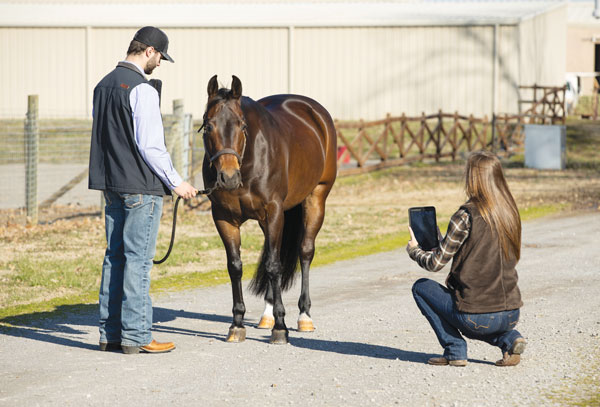
With virtual veterinary care for horses, owners can snap a photo or take a short video documenting a horse’s ailment, send it to their veterinarian, and receive an opinion back in a matter of minutes or hours. When your horse is colicking or bleeding from an injury, nothing replaces an emergency visit from your veterinarian. But to address minor complaints like skin conditions, mysterious insect bites and other lumps and bumps, there’s a way to get advice from your veterinarian without waiting for a farm call.
Just a Phone Call Away
As an equine veterinarian and lameness specialist based in Hoschton, Ga., Grisel has offered telemedicine services through his practice, the Atlanta Equine Clinic, for approximately 20 years. At first, most of Grisel’s telemedicine requests came by email or phone call. But when the first smartphones hit the market in the late 2000s, Grisel says requests for telemedical services in his practice soared, ultimately increasing by 3,600 percent between 1998 and 2013.
Today, Grisel estimates that 40 percent of his time spent practicing is via virtual veterinary care for horses. Licensed to practice in multiple states with clients all over the Southeast, Grisel has made telemedicine an invaluable part of his practice. He’s also not alone: many equine veterinarians across the United States practice some form of telemedicine.
“It’s natural for horse owners to solicit veterinarians in this way, and veterinarians like it because they can keep regular tabs on their patients,” Grisel says. “It’s a very natural progression for the veterinary industry because of the technology that’s now available.”
Equipped with both photo and video capabilities, as well as an internet connection, the smartphone in nearly every horse owner’s pocket is the perfect vehicle for transmitting crucial information about your horse to your veterinarian.
“Technology has opened up an entirely new way of caring for our animals,” Grisel says. “It also keeps horse owners constantly connected to our practice.”
Pocket Vet
While equine telemedicine can be invaluable, it’s important for everyone involved to use the service responsibly for the good of the horse. According to the American Association of Equine Practitioners’ 2018 white paper on telehealth, a veterinarian-client-patient relationship (VCPR) must exist before a veterinarian practices telemedicine.

“Any time a veterinarian provides an opinion about a horse, they are practicing medicine,” Grisel explains. “If I am going to prescribe medications or give advice about how to diagnose or treat an animal, I have to have a VCPR in place. Which means that at some point, I’ve had to be in the presence of that horse. I also have to be licensed in the state where the animal is located. In addition to those things, I have to keep appropriate medical records.”
For the horse owner, this means that virtual veterinary care for horses should only be performed by the veterinarian who has already established an in-person relationship with you and your horse. Besides the legal and ethical ramifications, there’s also a practical side. With a VCPR, your veterinarian is already familiar with your horse and his treatment history.
“The client should use their personal veterinarian for a lot of reasons, but number one, the veterinarian has that personal relationship with the horse,” Grisel explains. “They know if that horse shows pain or hides pain, for example. They also know what’s going on with the horse and any medical treatment the horse has had, so they can prescribe medications accordingly.”
Many veterinarians also use telemedicine to communicate with each other about cases, says Bill Barnes, DVM, a mobile equine veterinarian based in Saratoga Springs, N.Y. This is known as “teleconsulting.”
“Telemedicine can be used internally within the profession to exchange information,” says Barnes. “We can use it in emergencies, in orthopedic situations by sharing radiographs, or by looking at soft tissue with ultrasounds, or for skin issues like dermatitis.”
Since Barnes’ practice is mobile, he has clients all across the East Coast and frequently practices telemedicine to keep tabs on his patients. In situations that turn out to be emergencies, Barnes may troubleshoot long distance, but he’ll also work to connect his patients with a local vet to provide immediate assistance.
How to Use It
In telemedicine, your vet only gets the information you relay through words, photos or videos, so relaying that information correctly is key to using the service. Horse owner Donna Christopher of Bahama, N.C., uses virtual veterinary care for horses to communicate with Grisel between farm visits.
“One thing you have to realize about telemedicine is that you are your vet’s eyes and ears on the ground,” says Christopher. “Your vet can only be as good as the information you provide.” Here are some tips for providing the clearest information you can to your veterinarian via equine telehealth.
◆ Communicate the Issue Clearly. Whether by text, phone call or email, be brief and succinct. Give your vet a run-down of the situation, including your horse’s vital signs, descriptions of his behavior, and any other relevant details.
◆ Take Clear, Well-Lit Photos and Videos. Smartphones can produce excellent photos and videos, but make sure you’re providing enough light to show the problem clearly.
“I have an iPhone, which makes life really easy, but getting out into the sunlight is key,” says Liz Bromberg, an amateur dressage rider in Chapel Hill, N.C. “I’ll take multiple pictures or videos, then go back and pick the ones that I think show the issue best.”
◆ Follow Your Vet’s Directions. If there is an issue with your horse, your vet may have some instructions for you, like administering a medication or asking you to send a follow-up video showing your horse moving in a certain direction. Make sure you understand your vet’s instructions and how to follow them, especially when it comes to medications.
“When your vet is there on the farm with you, pay attention to what he says and watch how he examines the horse,” says Christopher. “That way, you’re educating yourself and being a good customer so that when your vet isn’t there and you’re trying to communicate later, you can give him exactly the kind of information he needs.”
Telemedicine is an excellent supplement to your relationship with your veterinarian, but it isn’t a replacement for regular veterinary care.
For many horse owners, virtual veterinary care for horses is a great way to get peace of mind for the kinds of health issues that crop up in every horse now and then. For dressage trainer Lynn Leath of North Star Training Center in Chapel Hill, N.C., using telemedicine to communicate with her vet helps her to detect small problems before they become big ones.
“I can pull up my iPad or my iPhone, take video of the horse trotting in one direction and then the other, and send it off to Dr. Grisel,” she says. “The next time he gets a chance to open up his phone or computer, he’s got an answer back to me via text, email or voicemail.”
This article about virtual veterinary care for horses appeared in the May 2020 issue of Horse Illustrated magazine. Click here to subscribe!
Smartphone Camera Tips You don’t have to be a filmmaker or a Hollywood director to produce a good video on your smartphone, but it helps to follow these basic principles for shooting video for your veterinarian. ◆ Ask for Help. Chances are good you won’t be able to lead your horse and also video well, so find a friend at the barn to lead your horse for you while you film. ◆ Shoot Horizontally, Not Vertically! Shooting video horizontally with your smartphone helps keep your whole horse in the frame, which is especially helpful if you’re trying to show lameness or soreness. ◆ Light it Up! Natural sunlight is best. Put your back toward the sun so that your shadow falls in front of you. This helps ensure the horse is lit without glare. ◆ Watch Your Screen. Be sure to watch your screen while recording so that you can note if you’re shaking or tilting the camera or cutting off your horse’s head or feet. ◆ Avoid Shaky Camera Syndrome. You can purchase an inexpensive mini tripod for your smartphone, but you can also stabilize yourself by leaning against a wall, resting your elbows on a fence rail or other steady object, or closing your elbows against your sides to steady your forearms. |






However, due in part to constant deworming, parasite resistance has become a significant problem.